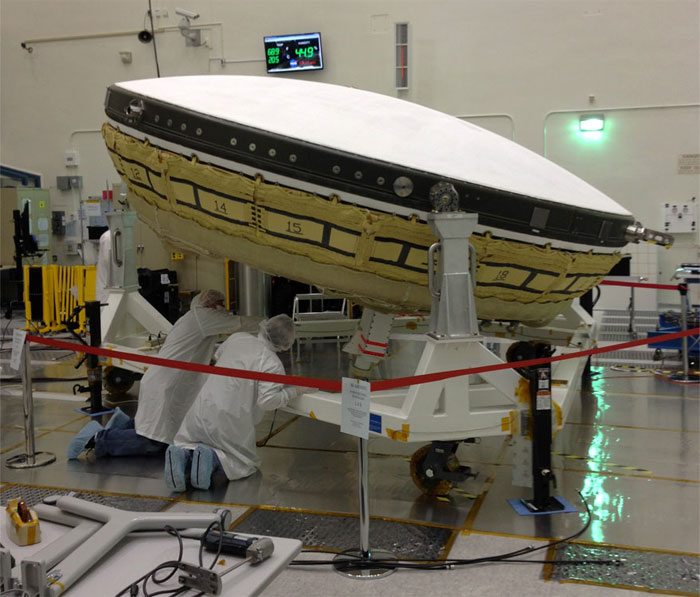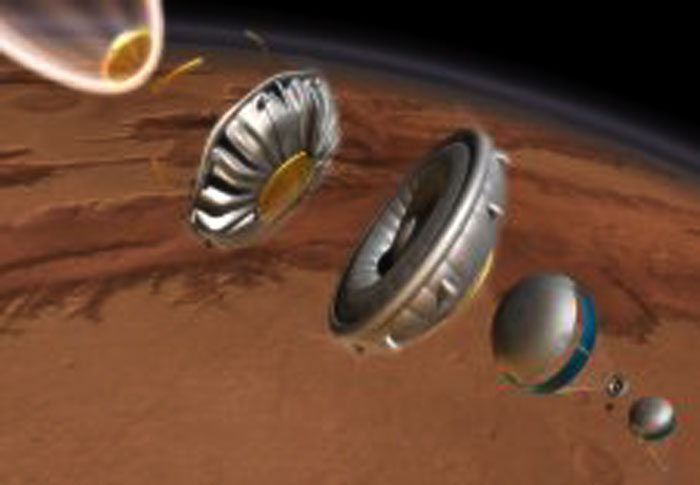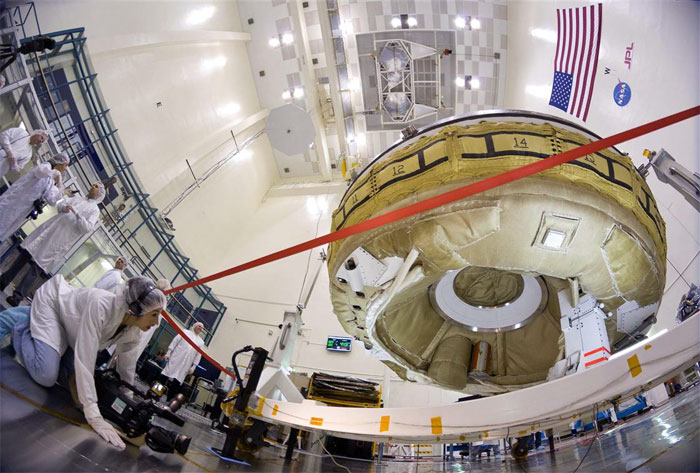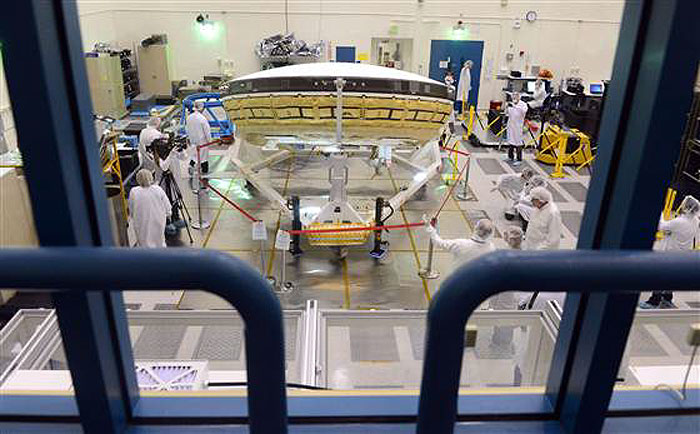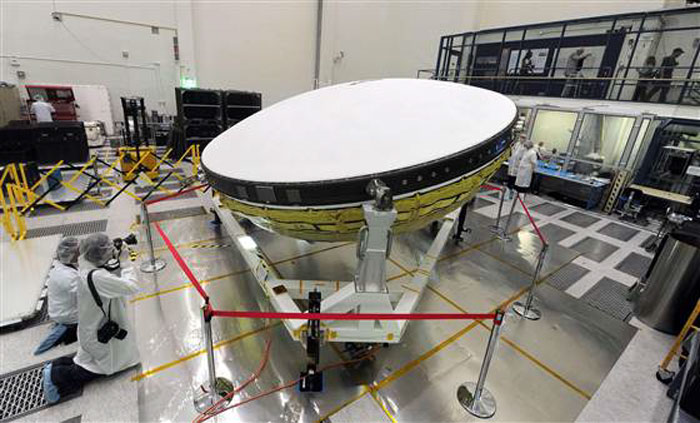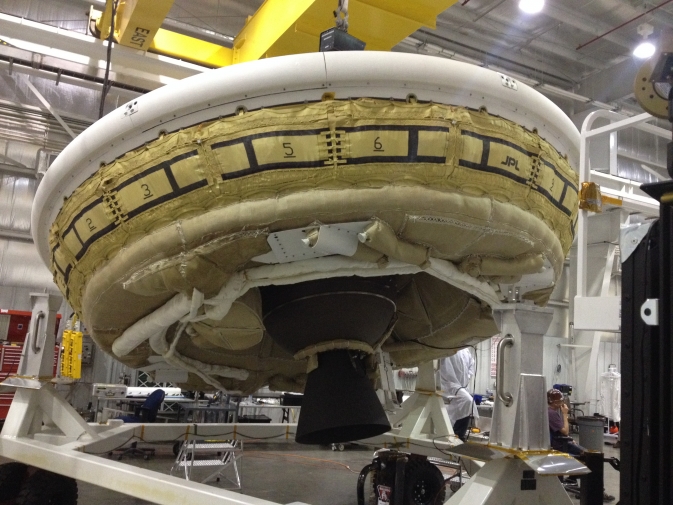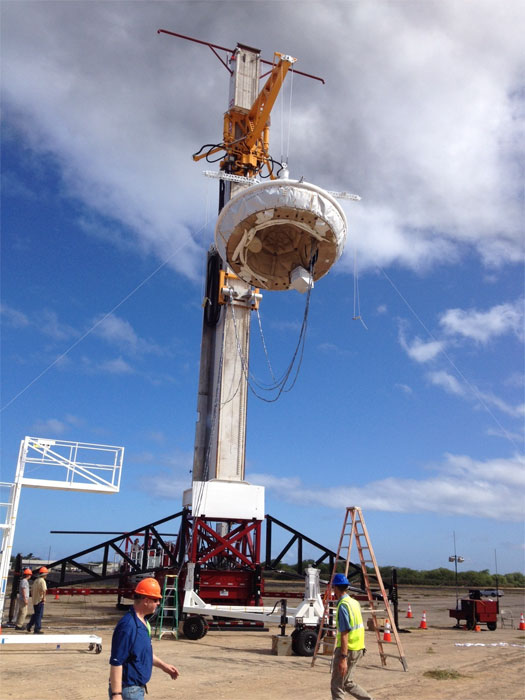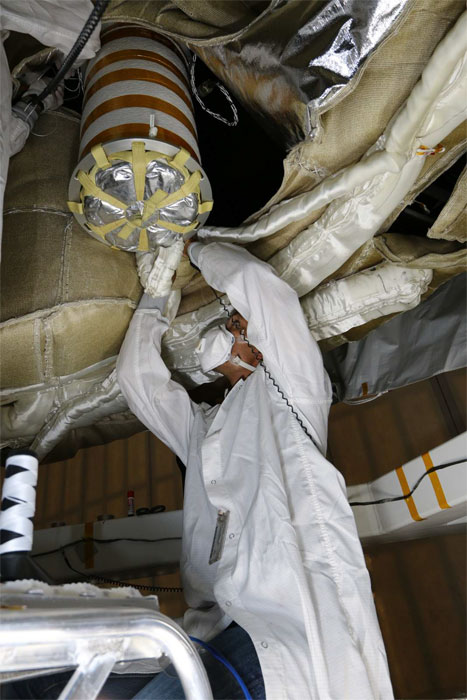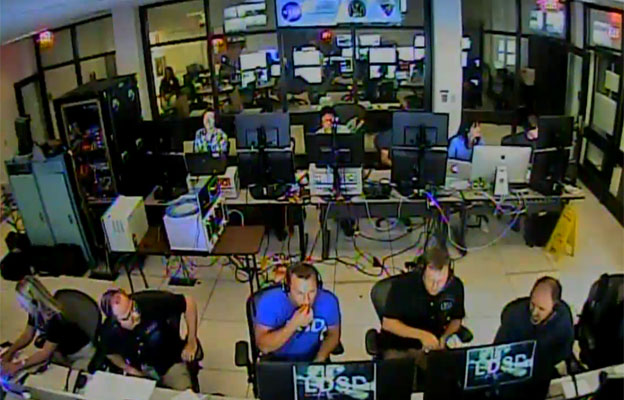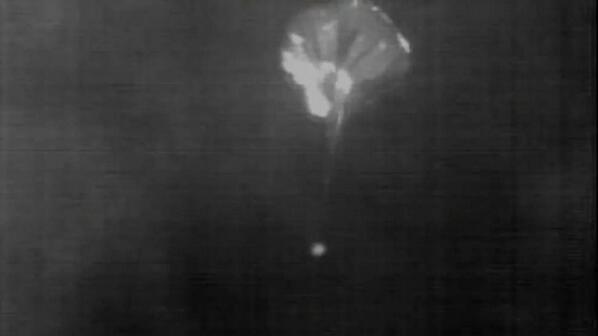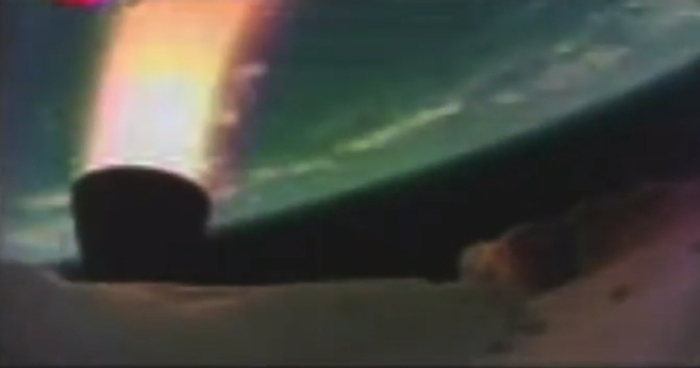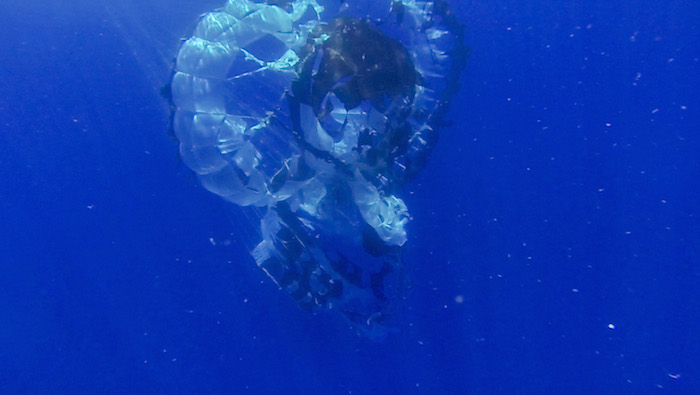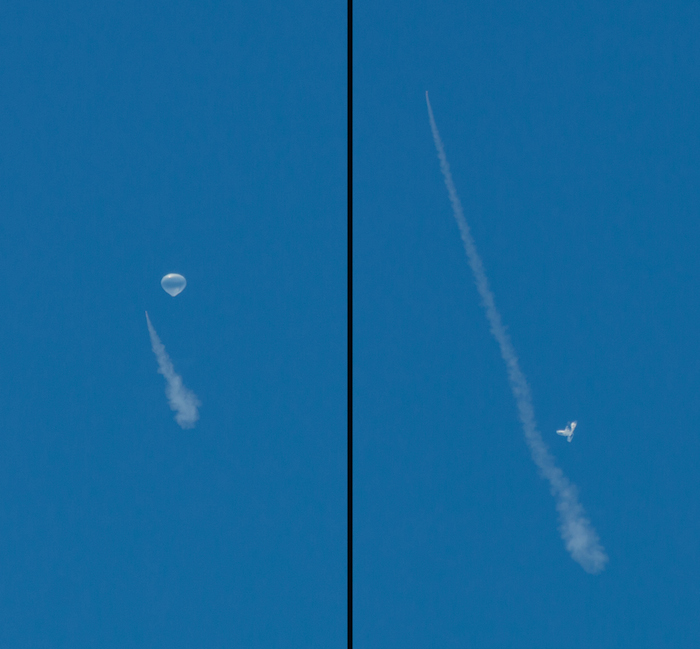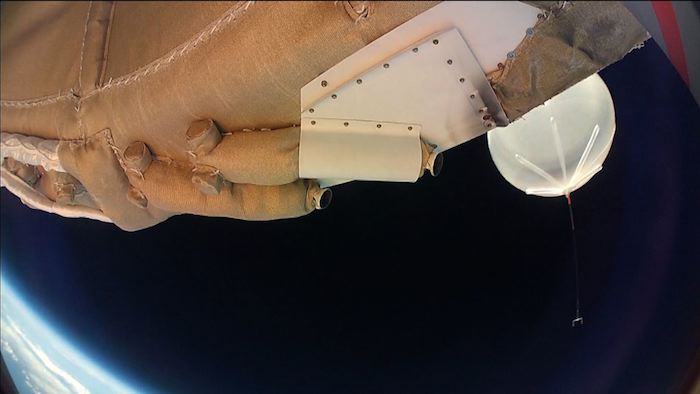NASA's Low-Density Supersonic Decelerator (LDSD) project, a rocket-powered, saucer-shaped test vehicle, has completed final assembly at the U.S. Navy's Pacific Missile Range Facility in Kauai, Hawaii.
This experimental flight test is designed to investigate breakthrough technologies that will benefit future Mars missions, including those involving human exploration. Three weeks of testing, simulations and rehearsals are planned before the first launch opportunity on the morning of June 3. LDSD was built at NASA's Jet Propulsion Laboratory, Pasadena, California, and shipped to Kauai for final assembly and preparations.
"Our Supersonic Flight Dynamics Test Vehicle number 1 arrived at the Navy's Pacific Missile Range Facility on April 17," said Mark Adler, project manager of the Low Density Supersonic Decelerator project from JPL. "Since then, we have been preparing it for flight. One of the last big assemblies occurred on April 30, when we mated the vehicle with its Star-48 booster rocket."
During the June experimental flight test, a balloon will carry the test vehicle from the Hawaii Navy facility to an altitude of about 120,000 feet. There, it will be dropped and its booster rocket will quickly kick in and carry it to 180,000 feet, accelerating to Mach 4. Once in the very rarified air high above the Pacific, the saucer will begin a series of automated tests of two breakthrough technologies.
In order to get larger payloads to Mars, and to pave the way for future human explorers, cutting-edge technologies like LDSD are critical. Among other applications, this new space technology will enable delivery of the supplies and materials needed for long-duration missions to the Red Planet.
The upper layers of Earth’s stratosphere are the most similar environment available to match the properties of the thin atmosphere of Mars. The Low Density Supersonic Decelerator mission developed this test method to ensure the best prospects for effective testing of the new and improved technologies here on Earth.
Anyone with Internet access will be able to watch live as video from the June test is relayed from the vehicle to the ground. The low-resolution images from the saucer are expected to show the vehicle dropping away from its high-altitude balloon mothership and then rocketing up to the very edge of the stratosphere. The test vehicle will then deploy an inflatable Kevlar tube around itself, called the Supersonic Inflatable Aerodynamic Decelerator (SIAD). After the SIAD inflates, the test vehicle will deploy a mammoth parachute called the Supersonic Disk Sail Parachute.
While people watching at home may be fascinated by how these two new technologies operate, the NASA flight team will actually be concentrating on a more fundamental question – "Will the test vehicle work as planned?"
"This first test is a true experimental flight test," said Ian Clark, the LDSD principal investigator from JPL. "Our goal is to get this first-of-its-kind test vehicle to operate correctly at very high speeds and very high altitudes. "
Although there is no guarantee that this first test will be successful, regardless of the outcome, the LDSD team expects to learn a great deal from the test. NASA has two more saucer-shaped test vehicles in the pipeline, with plans to test them from Hawaii in summer of 2015.
"We are pushing the envelope on what we know," said Clark. "We are accepting higher risk with these test flights than we would with a space mission, such as the Mars Science Laboratory. We will learn a great deal even if these tests, conducted here in Earth's atmosphere at relatively low cost, fail to meet some of the mission objectives."
As NASA plans increasingly ambitious robotic missions to Mars, laying the groundwork for even more complex human science expeditions to come, the spacecraft needed to land safely on the Red Planet's surface will become larger and heavier. This new technology will enable those important missions.
.
In this picture, NASA’s saucer-shaped experimental flight vehicle is prepared for a Range Compatibility Test at the US Navy’s Pacific Missile Range Facility in Kaua‘i, Hawaii.
.
.
What will it take to land heavier spacecraft on Mars? How will engineers slow large payloads traveling at supersonic speeds in a thin Martian atmosphere? Can this be done?
NASA’s Wallops Flight Facility is playing an integral role in potentially answering those questions with the Low Density Supersonic Decelerator mission, or LDSD.
To conduct advanced exploration missions in the future and safely land heavier spacecraft on Mars, NASA must advance the technology of decelerating large payloads traveling at supersonic speeds in thin atmospheres to a new level of performance. The current technology for decelerating payloads dates back to NASA’s Viking Program, which placed two landers on Mars in 1976. That same technology is still being used and most recently delivered the Curiosity rover to Mars in 2012.
Future robotic missions to Mars and even future human exploration will require more massive payloads than previously sent to the surface of the Red Planet. To accomplish these goals, NASA is developing new systems to deliver this important cargo to the surface of Mars.
NASA scientists and engineers borrowed a technique used by the ‘o’opu hue, also known as the Hawaiian pufferfish. The technique? Rapid inflation. For the pufferfish, it is simply a defense mechanism. For NASA, it is potentially the element that links to the future of space exploration.
Set for a test launch in early June from the Pacific Missile Range Facility in Hawaii, LDSD will use a 20-foot diameter, solid rocket-powered balloon-like vessel called a Supersonic Inflatable Aerodynamic Decelerator (SIAD) to test these capabilities.
To duplicate many of the most important aspects of Mars’ thin atmosphere, NASA plans to use the very thin air found high in Earth’s stratosphere as a test bed for the LDSD mission.
To reach the desired altitude of 120,000 feet, the LDSD project will use a helium-filled scientific balloon provided by NASA’s Wallops Flight Facility and Columbia Scientific Balloon Facility. When fully deployed, the balloon itself is over 34 million cubic feet. At that size alone, one could fit a professional football stadium inside it. The material that makes the balloon, a very thin film called polyethylene that is similar thickness to that of sandwich wrap, will lift the massive test article to 120,000 feet.
At that altitude, the test article will be detached from the balloon and a solid rocket motor will be employed to boost the test article on a trajectory to reach supersonic speeds (Mach 4) needed to test the SIAD.
Once at supersonic speeds, the deployment and function of the inflatable decelerators will be tested to slow the test article to a speed where it becomes safe to deploy a supersonic parachute. The balloon and test article will all be recovered from the ocean.
Two recovery vessels, Kahana and Konua, will recover the test article and balloon respectively. Before the articles can be recovered, a G-2 and a C-26 aircraft will focus on determining positioning of the articles for recovery. Wallops, with extensive experience vehicle recovery, will oversee the recovery operations for the LDSD mission.
In addition to the balloon operations and oversight of recovery, Wallops is the range services coordinator, has provided the core electronics for the test article and electrical ground support equipment.
NASA has identified six potential launch dates for the balloon carrying LDSD: June 3, 5, 7, 9, 11, and 14. The June 3 launch window extends from 8 a.m. to 9:30 a.m. HST, or 2 p.m. to 3:30 p.m. EDT. The test can be viewed live on NASA TV beginning at 7:45 a.m. HST (1:45 p.m. EDT).
Quelle: NASA
.
Update: 3.06.2014
.
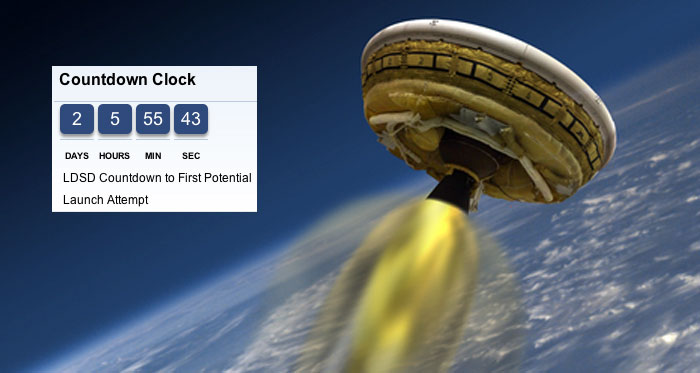
NASA's 'Flying Saucer' Readies for First Test Flight
.
NASA's flying saucer-shaped test vehicle is ready to take to the skies from the U.S. Navy's Pacific Missile Range Facility in Kauai, Hawaii, for its first engineering shakeout flight.
The first launch opportunity for the test vehicle is June 3, when the launch window opens at 8:30 a.m. HST. The test will be carried live on NASA TV and streamed on the Web. The Low Density Supersonic Decelerator (LDSD) will gather data about landing heavy payloads on Mars and other planetary surfaces.
"The agency is moving forward and getting ready for Mars as part of NASA's Evolvable Mars campaign," said Michael Gazarik, associate administrator for Space Technology at NASA Headquarters in Washington. "We fly, we learn, we fly again. We have two more vehicles in the works for next year."
As NASA plans increasingly ambitious robotic missions to Mars, laying the groundwork for even more complex human science expeditions to come, accommodating extended stays for explorers on the Martian surface will require larger and heavier spacecraft.
The objective of the LDSD project is to see if the cutting-edge, rocket-powered test vehicle operates as it was designed -- in near-space at high Mach numbers.
"After years of imagination, engineering and hard work, we soon will get to see our Keiki o ka honua, our 'boy from Earth,' show us its stuff," said Mark Adler, project manager for the Low Density Supersonic Decelerator at NASA's Jet Propulsion Laboratory (JPL) in Pasadena, California. "The success of this experimental test flight will be measured by the success of the test vehicle to launch and fly its flight profile as advertised. If our flying saucer hits its speed and altitude targets, it will be a great day."
The way NASA's saucer climbs to test altitude is almost as distinctive as the test vehicle itself.
"We use a helium balloon -- that, when fully inflated, would fit snugly into Pasadena's Rose Bowl -- to lift our vehicle to 120,000 feet," said Adler. "From there we drop it for about one and a half seconds. After that, it's all about going higher and faster -- and then it's about putting on the brakes."
A fraction of a second after dropping from the balloon, and a few feet below it, four small rocket motors will fire to spin up and gyroscopically stabilize the saucer. A half second later, a Star 48B long-nozzle, solid-fueled rocket engine will kick in with 17,500 pounds of thrust, sending the test vehicle to the edge of the stratosphere.
"Our goal is to get to an altitude and velocity which simulates the kind of environment one of our vehicles would encounter when it would fly in the Martian atmosphere," said Ian Clark, principal investigator of the LDSD project at JPL. "We top out at about 180,000 feet and Mach 4. Then, as we slow down to Mach 3.8, we deploy the first of two new atmospheric braking systems."
The project management team decided also to fly the two supersonic decelerator technologies that will be thoroughly tested during two LDSD flight tests next year.
If this year's test vehicle flies as expected, the LDSD team may get a treasure-trove of data on how the 6-meter supersonic inflatable aerodynamic decelerator (SIAD-R) and the supersonic parachute operate a full year ahead of schedule.
The SIAD-R, essentially an inflatable doughnut that increases the vehicle's size and, as a result, its drag, is deployed at about Mach 3.8. It will quickly slow the vehicle to Mach 2.5 where the parachute, the largest supersonic parachute ever flown, first hits the supersonic flow. About 45 minutes later, the saucer is expected to make a controlled landing onto the Pacific Ocean off Hawaii.
Quelle: NASA
.
Update: 7.06.2014
.
NASA's Flying Saucer Cools Its Jets in Hawaiian Hangar
Technically speaking, NASA's Low-Density Supersonic Decelerator has a single 17,500-pound-thrust, solid-fueled rocket engine — and figuratively speaking, the saucer-shaped test vehicle is cooling its jets at the U.S. Navy's Pacific Missile Range Facility in Kauai, Hawaii, waiting for favorable winds.
NASA spokesman David Steitz told NBC News the winds are a no-go for a Saturday launch attempt, and that means Monday is the next opportunity to loft the 15-foot-wide saucer up to 120,000 feet at the end of a helium balloon. Once that happens, the LDSD can light its engine, rocket up to 180,000 feet and open up its inflatable, doughnut-shaped drag shield to slow its supersonic descent to the Pacific Ocean.
The point of the uncrewed flight isn't to spark a wave of UFO sightings, but to test technologies that could be used to land bigger payloads on Mars.
.
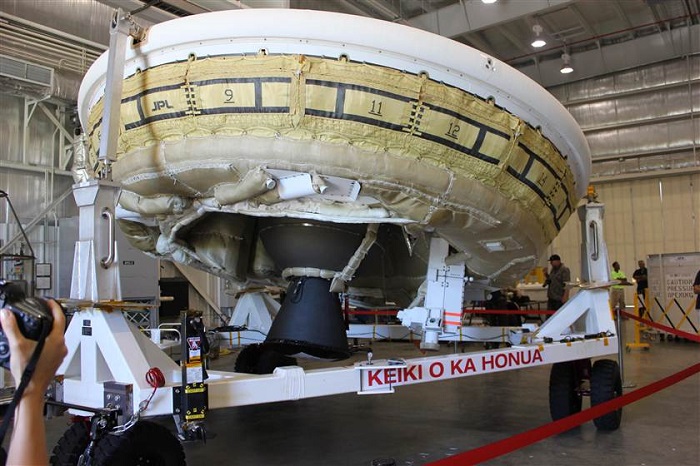
Quelle: NBC
.
Update: 9.06.2014
.
It's an Anomaly! Winds Keep NASA's Flying Saucer Grounded
Sorry, flying-saucer fans: Unfavorable winds have forced NASA to call off the launch of its saucer-shaped Low-Density Supersonic Decelerator for the fourth time in a week.
The prototype vehlcle, and the team behind it, will have to wait until Wednesday at the earliest to send the LDSD on a mission aimed at testing technologies that could be used for future landings on Mars.
The experiment at the U.S. Navy's Pacific Missile Range Facility in Kauai, Hawaii, was originally scheduled for June 3, then for the 5th, then the 7th, and then Monday. Each time, NASA has had to stand down.
"Wind conditions have been the prevailing factor in the launch delays," NASA spokeswoman Shannon Ridinger said in an email on Sunday.
The 15-foot-wide LDSD is supposed to be launched by a helium balloon to a height of 120,000 feet, and then blasted up to 180,000 feet by a solid-fueled rocket engine. As it descends at supersonic speeds, it would inflate an "inner tube" device to increase its diameter to 20 feet. The resulting atmospheric drag should slow the descent enough for the deployment of a super-strong parachute.
A more advanced version of the device could be used to help land multi-ton payloads on Mars. But for this test, NASA wants the LDSD prototype to fall into the Pacific Ocean — and that means upper-level winds have to blowing out to sea rather than inland. So far, the winds have been blowing in the wrong direction.
NASA spokesman David Steitz told NBC News that the current wind pattern appears to be anomalous.
"The LDSD team examined the weather records of PMRF [the Pacific Missile Range Facility] during the past two years, day-by-day, to pick the optimal time of year for cooperative atmosphere and winds," he wrote in an email. "This year, however, Mother Nature appears to have new plans for the winds over Hawaii."
After Wednesday, the team has one more opportunity on the schedule, on June 14. For additional background on NASA's flying saucer, take a look at last week's preview. And to find out which way the winds are blowing.
Quelle: NBC
.
Update: 25.06.2014
.
Flight Test for Next-Generation Mars Supersonic Decelerator Prototype Rescheduled for June 28
Anyone even remotely familiar with landing spacecraft and payloads on other worlds can respect how difficult such a feat really is, and it only gets more difficult as the spacecraft get larger and heavier. Mars rovers Spirit and Opportunity, each roughly the size of a golf cart, had to parachute in and land while cocooned inside a set of very sophisticated airbags, bouncing along the surface until coming to a stop. The rover Curiosity, which landed on Mars in August 2012, is the size of a SUV and carried out what is arguably the riskiest landing attempt of any spacecraft to date, touching down via a “sky-crane” which hovered thanks to rockets to lower the rover onto the surface.
Thing is, with the current landing technology available Curiosity is about as big a payload as we can land on Mars, and if mankind ever wants to land larger payloads, such as larger vehicles with crews or large amounts of supplies, then new technologies need to be developed to get the job done.
The space agency is also currently very restricted on where they can land, because the Martian atmosphere is so thin that current deceleration technologies do not allow for the time needed to slow down enough to land at higher elevations. NASA needs a new approach to make future missions to land on Mars possible, and the Low-Density Supersonic Decelerator (LDSD) will open up many more options for future locations by enabling landings at regions that cannot be currently accessed.
The first flight test of the LDSD was scheduled to take place earlier this month from the U.S. Navy’s Pacific Missile Range in Kauai, Hawaii, but mother nature did not want to cooperate, despite two years of research showing that the Kauai area had the proper wind conditions to carry the balloon out over the ocean for LDSD to launch. All six days of launch attempts were called off for unfavorable weather conditions.
“We needed the mid-level winds between 15,000 and 60,000 feet to take the balloon away from the island,” said Mark Adler, LDSD Project Manager from NASA’s Jet Propulsion Laboratory in Pasadena, CA. “While there were a few days that were very close, none of the days had the proper wind conditions.”
Now, after working with the Pacific Missile Range Facility and looking at weather conditions predicted for later in the month, NASA and the U.S. Navy are aiming to try again to fly the LDSD test article on June 28. If the LDSD cannot fly on June 28 then backup launch attempts are scheduled for June 29, June 30, July 1, and July 3.
“What folks may not realize is the variability of the weather in Kauai,” said Jody Davis, NASA Langley LDSD lead. “The island has many different types of terrain and is very mountainous, so there’s a lot of localized rain and storms. This test is very dependent on the wind direction and rain is bad for the test vehicle, so we can only launch the balloon in certain conditions.”
- Landing Bigger on Mars
“If we’re going to explore an asteroid and eventually put people on the surface of Mars then we need sustained and significant investment in new space technologies. Without those investments we won’t be able to take people in any sustained way beyond low-Earth orbit,” said Jeff Sheehy, Senior Technical Officer of Space Technology Mission Directorate from NASA Headquarters. “Assume we can land something twice as big as Curiosity, what could we do with that? Where could we explore? How much MORE could we explore? How much more could we learn? We’re looking forward to sample returns from Mars and putting enough cargo on Mars to support human exploration, and the LDSD project aims at providing the technologies for entry, descent, and landing, which is one of the major challenges for sustained exploration of Mars.”
The current technology used for decelerating from a high speed atmospheric entry to the final stages of landing on Mars dates back to NASA’s Viking Program in 1976, and the same basic parachute design has been used ever since. LDSD brings a much needed upgrade; the heavier landers of the future will instead use atmospheric drag as a solution, which will save rocket engines and fuel for final maneuvers and landing procedures. LDSD will also give NASA the capability to land payloads of up to 3 tons, twice what can currently be landed, while also improving landing accuracy from the current margin of 10 kilometers to a mere three kilometers.
“We have been using the same Viking parachute design and the same supersonic Viking parachute test data from 1972 to qualify and validate the operation of our parachutes on all of our Mars missions,” said Adler. “We’ve been pushing the limits of what we can squeeze out of that data, and we’re pretty much there, we’re at the limit. That would be fine if that’s all we wanted to do, but we want to go bigger, we keep getting bigger, we went from Sojourner to MER to Curiosity but that’s not good enough, we want to land bigger things, and we want to land them at higher altitudes and land more accurately.”
“The fundamental problem we have is things start going faster and faster through the Mars atmosphere as they get larger, and so we have to slow them down at higher altitudes and higher speeds,” added Adler. “Today we slow things down at about Mach 2, we’re going to have to go up to Mach 3 or Mach 4 and higher to start slowing bigger things down and that’s what this project is all about, developing new supersonic decelerators to slow things down at higher speeds.”
The LDSD project team has already completed three successful rocket sled tests of the “SIAD-R,” one of two Supersonic Inflatable Aerodynamic Decelerators that make up the three innovative deceleration systems now in development under the LDSD project (two SIADs of different sizes and an advanced parachute system). The tests on the balloon-like pressure vessel, which is designed to inflate around a vehicle and slow its entry, went well, despite the fact the test team put the SIAD-R through aerodynamic loads 25 percent greater than it will face during atmospheric entry at Mars.
“We inflated the SIAD-R on a rocket sled going about 250 mph to show that it could take the loads at Mars, so we simulated the loads this thing will actually experience when it actually lands at Mars,” said Adler. “We had to show that it would survive, that it inflated properly and wouldn’t rip off and show that it had the right characteristics that we would expect in a Mars flight. That all worked out great.”
.
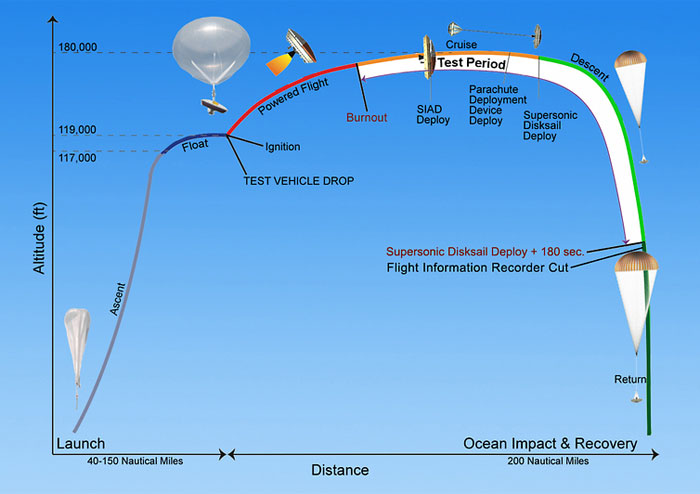
Timeline of Events for LDSD Flight Test. Image Credit: NASA / JPL-Caltech
.
- The Flight Test
Once mother nature decides to cooperate the LDSD will launch from the U.S. Navy’s Pacific Missile Range Facility in Kauai, Hawaii. A 34-million-cubic-foot helium balloon will lift the solid-rocket powered LDSD test vehicle to an altitude of 120,000 feet, at which point the vehicle will fire a large Star-48 rocket motor to accelerate to supersonic speeds and reach 180,000 feet, where the atmosphere of Mars can be simulated.
“We get to the altitudes of Mars in terms of density that we would be at when we conduct our flights there, then we fly horizontally at Mach 4. At about Mach 3.75 we will deploy the SIAD, which is where it has to deploy at Mars to start slowing us down at higher speeds,” said Adler. “Shortly after that we will deploy the parachute deployment device at Mach 2.75, then the parachute will come out at about Mach 2.5, then the whole thing comes down. So the whole test occurs in this horizontal phase at high altitude and we get all our data. We have tons of cameras, GPS, temperature sensors, pressure sensors, load cells and so on to give us information about these articles in flight so we can measure the dynamics, their performance, and so on to prove to ourselves that it will work at Mars if we did this there.”
.
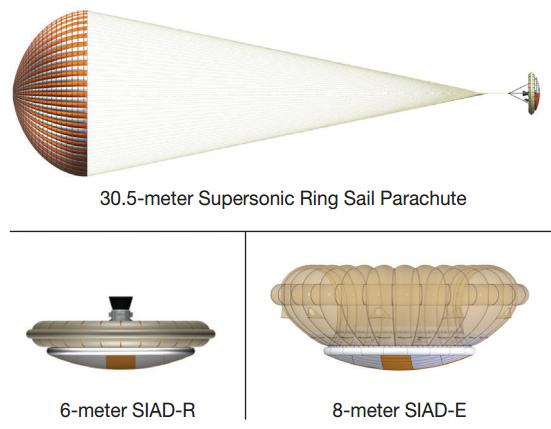
Two SIADs, which were inspired by a puffer fish’s ability to change its size rapidly without changing its mass, are being developed to serve two different purposes. A 20-foot-diameter (6-meter) SIAD will serve for landing smaller robotic payloads, and a 26-foot-diameter (8-meter) SIAD is being developed for landing larger payloads, including crews. The 100-foot-diameter parachute is also new; it’s twice as big as the parachute Curiosity used to land on Mars. It’s so big that it can’t even be tested in the world’s largest wind tunnel at AMES Research Center, instead the LDSD team had to conduct scale model tests to design the parachute for the actual flights. All three devices will be the largest of their kind ever flown at speeds several times greater than the speed of sound.
A series of flight tests are scheduled to take place in Hawaii through 2015, and the technology that comes from the LDSD project will be ready to support the missions it is designed for as soon as 2018. However, it may have to wait several more years before NASA has a reason to use it, because the space agency won’t be launching anyone anywhere until at least 2021, when the Space Launch System (SLS) and Orion spacecraft are scheduled to conduct the first crewed “deep-space” mission beyond low-Earth orbit. And if Congress continues to under-fund NASA, then it could be even longer before the missions that will need LDSD come to reality.
Quelle: AS
.
Update: 28.06.2014
.

The LDSD climbs into the sky underneath the balloon
.
The US space agency (Nasa) has launched an atmospheric test vehicle that looks every inch like a flying saucer.
In reality, the Low Density Supersonic Decelerator (LDSD) is a demonstrator for the type of technologies humans will need to land on Mars.
The LDSD has been sent into the stratosphere via a balloon off Hawaii.
It will trial a new type of parachute and an inflatable Kevlar ring that can help slow down a spacecraft as it approaches the Red Planet's surface.
Nasa says it is trying to raise the current maximum mass that can be put on Mars from 1.5 tonnes to something nearer the 20-30 tonnes a human mission might require.
Ian Clark, the LDSD's principal investigator told BBC News: "We're testing technologies that will enable us to land bigger payloads, much heavier payloads, at higher altitude and with more accuracy than we've ever been able to do before."
The experiment was launched from the US Navy's Pacific Missile Range Facility in Kauai, Hawaii.
A helium balloon lifted the LDSD clear of the ground at 08:47 local time (18:47 GMT). It was due to take a couple of hours to raise the vehicle to about 35km (120,000ft) before releasing it.
Low Density Supersonic Decelerator (LDSD)
A rocket motor should then kick the vehicle on up to about 55km (180,000ft) and a velocity of about Mach 4 (four times the speed of sound).
As the LDSD begins to slow, it will deploy its two new atmospheric braking systems.
The first to come out will be the 6m (20ft) inflatable "donut". This will increase the vehicle's size and also, as a result, its drag.
Once the velocity has dropped to about Mach 2.5, the parachute will come out.
“The supersonic parachute we’re testing is enormous,” says Ian Clark.
“It’s 100ft (30m) in diameter; it generates two-and-a-half times the drag of any previous parachute we’ve sent to Mars. We’re going to use it at a velocity that’s faster than we’ve used a parachute at Mars.
“We’re really going to push it to the edge where the materials themselves, the nylons and Kevlars that the parachute is made of, may start melting.
“We don’t know; that’s why we do this testing.”
Assuming the structures all stay intact, the parachute should drop the LDSD in the ocean after about 45 minutes.
Nasa's plan is to return next year with a larger ring and parachute to test.
The Curiosity rover, at one tonne, is the biggest object landed on Mars to date.
There is a recognition that this payload capability will have to be increased substantially if astronauts on the planet are to receive all the food supplies and equipment they need to survive.
.
Controllers have to wait a couple of hours until the balloon reaches the right altitude to begin the experiment
Quelle: BBC
.
NASA launches 'flying saucer" for tests of Mars entry technology
A huge high-altitude balloon took off from Hawaii Saturday, gracefully lifting a 3.5-ton flying saucer-shaped research vehicle on a ride to the edge of space for a dramatic rocket-powered test of an inflatable doughnut-like braking system and a huge supersonic parachute needed for future missions to Mars.
Flying at four times the speed of sound in the thin air of the extreme upper atmosphere, the test vehicle was expected to experience conditions similar to what a spacecraft would find plunging into the atmosphere of the red planet.
.
The heaviest spacecraft ever sent to the surface of Mars -- NASA's Mars Science Laboratory, or Curiosity rover -- tipped the scales at about one ton. To get heavier robots to the surface, and eventual crewed spacecraft that could weigh 20 tons or more, NASA must develop better atmospheric braking systems.
Enter the Low-Density Supersonic Decelerator, or LDSD, the first of three test vehicles to fly in a $200 million research program aimed at developing new technologies for future Mars missions.
The first test vehicle's high-altitude balloon, loaded with 34 million cubic feet of helium, lifted off from the U.S. Navy's Pacific Missile Range Facility on Kauai, Hawaii, at 2:40 p.m. EDT (GMT-4). Initial attempts to launch the craft earlier this month were blocked by the weather, but conditions were acceptable Saturday and the balloon was cleared for flight.
A live television feed showed the giant balloon climbing away, pulling the LDSD from its support cradle and up into the sky for an hours-long flight to an altitude of 120,000 feet.
"Landing on Mars is an extremely challenging thing to do," Ian Clark, LDSD principal investigator at the Jet Propulsion Laboratory in Pasadena, Calif., said during a preflight briefing "The atmosphere is extremely thin, it's about 1 percent the density of Earth's atmosphere. That means you need very large devices to react against the atmosphere to create the drag that we use to slow the vehicles down as they enter the atmosphere.
"If you want to land things that are even heavier than the Mars Science Laboratory, if you want to land several tons -- and as you cast your eyes to the horizon and you think about landing humans on the surface of Mars, missions that will be 10 to 15 tons, 20 tons or more -- you're going to need extremely large drag devices to slow those vehicles down. We don't have those currently, and that's what LDSD is developing."
The test vehicle features two new technologies. The first is an inflatable torus around a traditional heat shield known as the Supersonic Inflatable Aerodynamic Decelerator, or SIAD, that gives the test vehicle the general shape of a flying saucer. The second new technology is a huge parachute, the largest ever designed to deploy at more than twice the speed of sound.
.

A huge balloon loaded with 34 million cubic feet of helium billows as it climbs away from the U.S. Navy's Pacific Missile Range Facility on Kauai, Hawaii. The LDSD test vehicle is visible to the left, still attached to its support cradle. (Credit: NASA)
.
After reaching an altitude of 120,000 feet, or about 23 miles, the LDSD was to be released. After small rocket motors fire to spin the vehicle up for stability, an ATK Star 48 solid-fuel rocket motor was programmed to fire to accelerate the test article and boost it an additional 11 miles to some 180,000 feet, or 34 miles.
Flying at more than four times the speed of sound, the flight plan called for the heavily instrumented SIAD torus to inflate, expanding the diameter of the entry vehicle from about 15.4 feet to 19.7 feet. After slowing to about 2.5 times the speed of sound, the parachute was expected to unfurl to a diameter of 110 feet, quickly slowing the craft even more.
"What we're trying to do is replicate the environment in which these technologies would be used," Clark said. "That means replicating the atmosphere, in particular the density of the atmosphere, which at Mars is extremely thin. To find (those conditions) we have to go halfway to the edge of space, or about 180,000 feet here on Earth, to test these devices. And we have to go several times the speed of sound."
Four Go-Pro video cameras were on board to provide realtime coverage of the SIAD inflation and parachute deploy. Video from higher resolution cameras will be stored on board and recovered after the test vehicle splashes down in the Pacific Ocean at the end of its flight.
Mission duration, from balloon launch to splashdown, was expected to be about three hours.
"This is our first experimental test flight of this vehicle that is designed to carry the SIAD and the parachute to the proper conditions very high in Earth's atmosphere and very fast so that it looks like, to these articles, that they're flying at Mars," said Mark Adler, LDSD project manager at JPL. "So we test them in those conditions at full scale to make sure they're going to work at Mars."
The SIAD torus initially was tested at the Naval Air Weapons Station at China Lake, Calif., using a rocket sled to accelerate the device to several hundred miles per hour. To test the parachute, a long cable was connected, fed through a pulley system and attached to a rocket sled. The parachute then was released from a helicopter, the rocket sled was fired up and the parachute was pulled toward the ground with a force equivalent to about 100,000 pounds of drag.
"Our objectives for this first flight are to launch it from here, get the balloon off and out over the water, to get it up to altitude where we can drop the vehicle and conduct this powered flight and get the data back from it to see how it works," said Adler.
He stressed the test flight was just that, a test flight, and any number of things could go wrong. But "if we fire that motor and we get data back from it, that is a great day. That way we can learn exactly what happened and understand what to do for our next flights."
Two more LDSD vehicles are being built for "flights of record" next summer.
"We've been there before, eight successful landings on the surface of Mars, the United States leads in this area," said Mike Gazarik, director of space technology development at NASA Headquarters. "It's one of the more difficult challenges.
"When we look at the Curiosity rover, which landed two years ago, it's about a metric ton on the surface of Mars. We know that for exploration, for future robotic exploration, for future human exploration, we need more than that. ... And so for us, it's the challenges of Mars -- how do we get there, how do we land there, how do we live there, how do we leave there?"
The Low-Density Supersonic Decelerator "focuses on that very difficult challenge of landing there."
"We need to test and we need to learn," Gazarik said. "And we need to do it quickly and efficiently. ... It's about more mass, going to more elevations on the surface of Mars and landing more accurately."
Quelle: CBS
.

The test vehicle for NASA's Low-Density Supersonic Decelerator rides on a balloon to high altitudes above Hawaii.
Image Credit: NASA/JPL-Caltech
.
LDSD
.
Quelle: NASA
.
Update: 29.06.2014
.
Media Telecon: NASA Supersonic Test Flight Completed
.
.
A screen shot shows the LDSD test vehicle after it dropped from the balloon that lifted it to high altitudes and fired its rocket. The picture was taken by a low-resolution camera onboard the vehicle. Earth is the blue-green orb in the background.
.
A news teleconference has been scheduled for tomorrow, June 29, at 7 a.m. HST (10 a.m. PDT, 1 p.m. EDT) to discuss the near-space test flight of NASA's Low-Density Supersonic Decelerator (LDSD), which occurred today above the U.S. Navy's Pacific Missile Range Facility in Kauai, Hawaii.
The balloon launch occurred at 8:45 a.m. HST (11:45 a.m. PDT/2:45 p.m. EDT) from the US Navy's Pacific Missile Range Facility in Kauai, Hawaii. At 11:05 a.m. HST (2:05 p.m. PDT/5:05 p.m. EDT), the test vehicle dropped away from the balloon (as planned), and powered flight began. The balloon and test vehicle were about 120,000 feet over the Pacific Ocean at the time of the drop. The vehicle splashed down in the ocean at approximately 11:35 a.m. HST (2:35 p.m. PDT/5:35 p.m. EDT), after the engineering test flight concluded.
This test was the first of three planned for the LDSD project, developed to evaluate new landing technologies for future Mars missions. While this initial test was designed to determine the flying ability of the vehicle, it also deployed two new landing technologies as a bonus. Those landing technologies will be officially tested in the next two flights, involving clones of the saucer-shaped vehicle.
Initial indications are that the vehicle successfully flew its flight test profile as planned, and deployed the two landing technologies. The first is a doughnut-shaped tube called the Supersonic Inflatable Aerodynamic Decelerator (SIAD), with early indications that it deployed as expected. The second is an enormous parachute (the Supersonic Disk Sail Parachute). Imagery downlinked in real-time from the test vehicle indicates that the parachute did not deploy as expected.
In order to get larger payloads to Mars, and to pave the way for future human explorers, cutting-edge technologies like LDSD are critical. Among other applications, this new space technology will enable delivery of the supplies and materials needed for long-duration missions to the Red Planet.
The upper layers of Earth's stratosphere are the most similar environment available to match the properties of the thin atmosphere of Mars. The LDSD mission developed this test method to ensure the best prospects for effective testing of the new and improved technologies.
Quelle: NASA
.
Update: 9.08.2014
.
Ride Shotgun With NASA Saucer As It Flies to Near Space
.
NASA's Low-Density Supersonic Decelerator (LDSD) project successfully flew a rocket-powered, saucer-shaped test vehicle into near-space in late June from the U.S. Navy's Pacific Missile Range Facility on Kauai, Hawaii. The goal of this experimental flight test, the first of three planned for the project, was to determine if the balloon-launched, rocket-powered, saucer-shaped, design could reach the altitudes and airspeeds needed to test two new breakthrough technologies destined for future Mars missions.
Carried as payload during the shakeout flight were two cutting-edge technologies scheduled to be tested next year aboard this same type of test vehicle. The Supersonic Inflatable Aerodynamic Decelerator (SIAD) is a large, doughnut-shaped air brake that deployed during the flight, helping slow the vehicle from 3.8 to 2 times the speed of sound. The second, the Supersonic Disksail Parachute, is the largest supersonic parachute ever flown. It has more than double the area of the parachute which was used for the Mars Science Laboratory (MSL) mission that carried the Curiosity rover to the surface of Mars.
"A good test is one where there are no surprises but a great test is one where you are able to learn new things, and that is certainly what we have in this case." said Ian Clark, principal investigator for LDSD at NASA's Jet Propulsion Laboratory in Pasadena, California. "Our test vehicle performed as advertised. The SIAD and ballute, which extracted the parachute, also performed beyond expectations. We also got significant insight into the fundamental physics of parachute inflation. We are literally re-writing the books on high-speed parachute operations, and we are doing it a year ahead of schedule."
Hitching a ride aboard the 7,000-pound saucer were several high-definition video cameras. The arresting imagery is providing the engineers and scientists on the LDSD project with never before seen insights into the dynamics involved with flying such a vehicle at high altitudes and Mach numbers.
"As far as I am concerned, whenever you get to ride shotgun on a rocket-powered flying saucer, it is a good day," said Clark. "We hope the video will show everyone how beautiful and awesome the test was, and to just to give folks an insight into what experimental flight test is all about."
.
Moments into its powered flight, the LDSD test vehicle captured this image of the balloon which carried it to high altitudes. The image was taken by one of the saucer-shaped test vehicle's high-resolution cameras.
.
The test vehicle for NASA's Low-Density Supersonic Decelerator is seen here before and after the balloon that helped carry it to near-space was deflated.
.
Moments into its powered flight, the LDSD test vehicle captured this image of the balloon which carried it to high altitudes. The image was taken by one of the saucer-shaped test vehicle's high-resolution cameras.
Quelle: NASA

